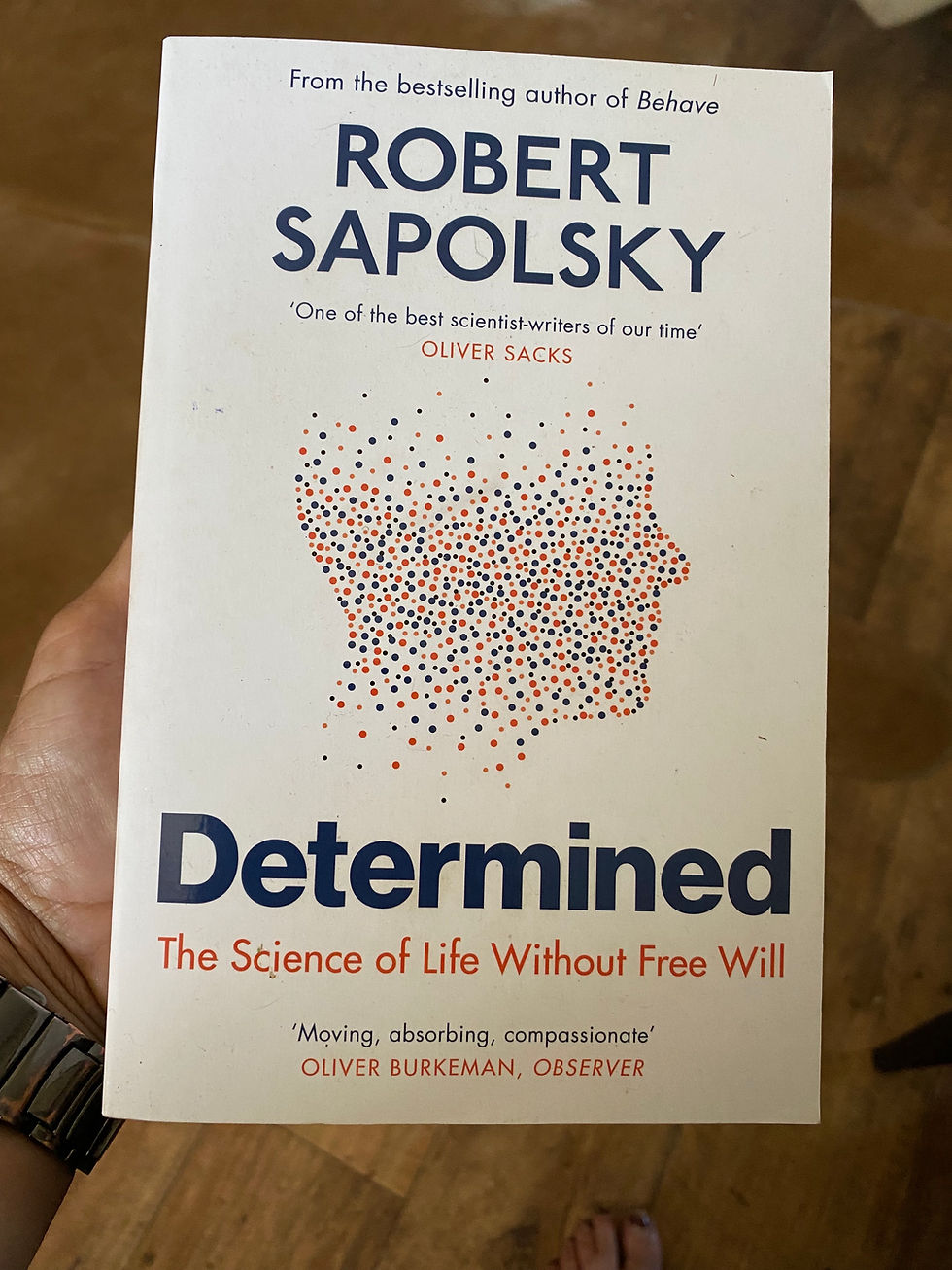“It Wasn’t Me, It Was My Neurons!”
- Georgina Brown (hershe)

- Jul 10
- 3 min read
Updated: Jul 12
A Review of Determined by Robert Sapolsky (and Why EDI Leads Need to Read It)
You know that moment when someone says something utterly biased, and instead of rolling your eyes or plotting their slow demise via calendar invites, you take a breath and think:
“What’s going on in their brain right now?”
Congratulations. You just stepped into Sapolsky-land.
In his groundbreaking book, Determined: The Science of Life Without Free Will, legendary neuroscientist Robert Sapolsky pulls no punches:
Free will? It's an illusion. Behaviour? It’s biology, baby. That thing you thought you chose to do just now? Neural history says otherwise.
And before you despair or scream, “So nothing matters?! I am just sleepwalking through life?” hold up. Because as an inclusion practitioner or leader, this book might just blow your brain open in the best possible way.
The TL;DR: We’re Not As Free As We Think
Sapolsky’s central argument is that everything we do is the result of a vast chain of prior causes, genetics, hormones, childhood experiences, social context, epigenetics, and even what your blood sugar was doing this morning.
You didn’t lose your temper because you’re impatient.
You lost it because cortisol met a threat, met poor sleep, and a 7 am Teams meeting.
So what does this have to do with inclusion?
Absolutely everything.
Inclusion Isn’t Just About Belief. It’s About Biology.
One of the stickiest problems in EDI work is this assumption:
“If people just tried harder to be inclusive, they would be.”
But Sapolsky and neuroscience tell a different story.
Most exclusionary behaviour isn’t deliberate.
It’s patterned. Primed. Preconscious.
People aren't always resistant. Their brains are just... predictable.
"Oh no, not again, someone’s being difficult.”→ More likely: someone’s amygdala has detected social threat, and they’re in defence mode.
“They should know better by now.”→ Possibly: They’ve had 20 years of patterning that contradicts everything you just said.
Enter NIMM: The Compassionate Disruptor
At BARDO, our Neuro-Inclusive Maturity Model (NIMM) doesn’t shame the brain.
It studies it.
Listens to it.
And then helps it gently unlearn.
Because if we understand that people are running predictable neuro-patterns, not being wilfully obtuse, we can finally design inclusion work that actually sticks.
NIMM works precisely because we don’t assume free will is running the show. We scaffold learning to interrupt, observe, and shift those automatic responses over time, and we bake in the biology.
It’s not just bias training. It’s brain rewiring.
It’s not just policies. It’s a pattern disruption.
It’s not just culture change. It’s neuroplasticity in action.
Three A-Ha Moments From Determined That Inclusion Needs
1. "Genes load the gun. Environment pulls the trigger."
Your team’s behaviour is shaped by decades of inputs. If we want to change it, we need to change the context, not just the message.
→ NIMM Tip: Don’t just run a one-off session. Change the social cues, defaults, and daily nudges. That’s how you reshape the wiring.
2. “Intent is a red herring.”
People can mean well and still cause harm. We need to move from “What did they mean?” to “What did their brain do under pressure?”
→ NIMM Tip: Teach the neuroscience of stress, safety, and perception, then you’re not blaming. You’re building capacity.
3. “Free will is not required for accountability.”
This is a big one. Just because people aren’t choosing bias doesn’t mean they don’t need to change. But that change must come from understanding, not punishment.
→ NIMM Tip: Compassionate accountability is our jam. No shame, no blame, just rewiring with respect.
So, Where Does This Leave Us?
Are we just meat puppets with no agency, flailing through unconscious patterns?
Maybe a little.
But that’s not the point.
The point is this:
Real inclusion work starts when we accept the biology of being human.
That brains are lazy, fast, scared, and brilliant, all at once.
And that when we design with those brains in mind, the results are transformational.
We don’t have to ditch agency.
But we do need to stop assuming that knowledge = behaviour.
Because knowing better doesn’t make people do better, not unless their brains are ready, safe, and rewired to respond differently.
Sapolsky’s book might just be the nudge we need to stop fighting resistance and start understanding it.
Final Thought:
Inclusion is not about forcing people to care. It’s about creating conditions where the brain can.
So, if you’re ready to move past checkbox training and start engineering actual change, grab Sapolsky’s book, have your worldview gently smashed to bits, then come talk to us about NIMM.
Because the brain was never the problem. We just didn’t know how to work with it.






Comments